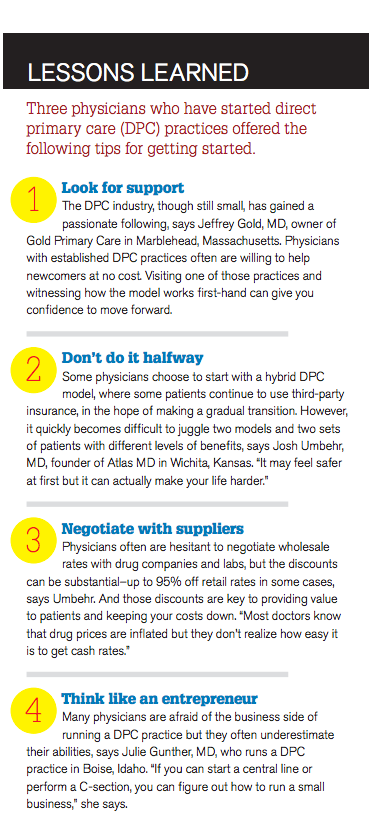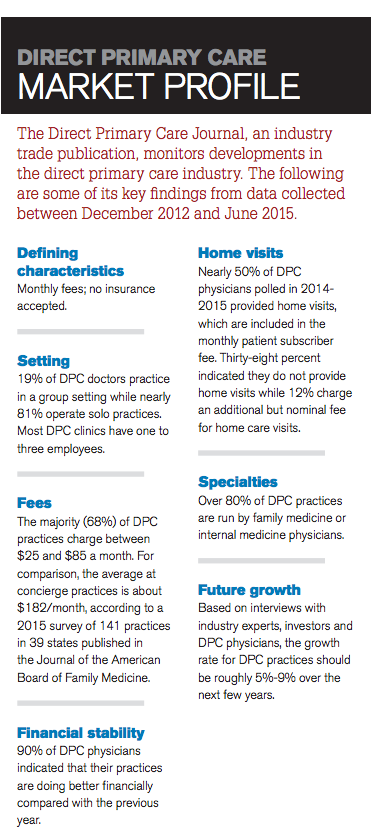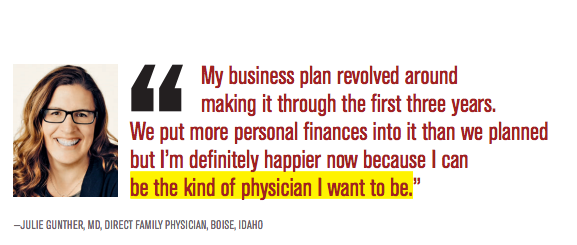Article
Physicians chart new path into direct primary care
Author(s):
Entrepreneurial docs make it work by cutting out third-party payers and negotiating with suppliers

Primary care physician Jeffrey Gold, MD, followed a traditional career path when he finished his residency about 10 years ago. He started at a private clinic then joined a large physician group in the Boston, Massachusetts area. Five years into that job, however, he became disillusioned by the system and began to consider striking out on his own.
âWorking as an employee worked well for about five years when I was busy and starting a family and wanted the guaranteed salary,â says Gold, a family physician and owner of Gold Direct Care in Marblehead, Massachusetts. âThen one day I realized I was actually annoyed at a patient for talking too long and realized it wasnât really her I was annoyed with, but a healthcare system that gives me about 10 minutes with each patient.â

It was around that time that he heard about the direct primary care (DPC) movement that was beginning to gain traction in a few states. The model is similar to concierge care, in which patients pay a premium for better access and extra services, but with a couple of key differences.
In concierge practices, physicians typically collect monthly or annual fees for extra services while also billing third-party insurance, whereas most DPC practices operate on a cash-only basis and do not work with third-party payers (although patients are encouraged to have catastrophic coverage.) In addition, DPC practices typically charge much lessâabout $77/month, on average, compared with an average of around $180/month at concierge practices.
Gold eventually left his job to launch Gold Direct Care in February 2015. He hopes to break even by the end of this year if membership continues to grow at its current pace of 12 to 15 enrollees per month.
Gold is part of a small but growing segment of primary care physicians who have adopted the DPC model, says Julie Gunther, MD, a Boise, Idaho-based DPC family physician who serves on the steering committee of the DPC Coalition, a national advocacy group. DPC first started to take hold in the United States in the late 1990s. Today, there are about 345 DPC clinics in 45 states, up from 300 in 39 states about a year ago, says Gunther.
Getting started
The biggest barriers to entry for many physicians are fear of losing income during the transition and aversion to taking risks, says Gunther. âYou do need to have some tolerance of risk and interest in entrepreneurship but we have a very supportive community that can help you get started.â
For Gold, visiting an established practice was instrumental in his decision to convert to DPC. As part of his market research, he flew to Wichita, Kansas, to meet with family physician Josh Umbehr, MD, founder of
Atlas MD, and returned home completely sold on making the transition.

âI was seeing 25 patients a day and they were seeing 25 patients in a week between three physicians,â Gold recalls. âThey had some wealthy patients but they also had many working-class patients who were looking for affordable, high-quality care where they wouldnât be treated like a numberâthatâs what really convinced me to give it try.â
Umbehr launched Atlas MD straight out of residency in 2010 and has since taken on four partners and grown to 600 patients per physician. Perceiving a lack of DPC resources and help for new practices, he created an online DPC curriculum for start-ups and has provided free consulting to more than 165 physicians over the past two years.
âMost doctors we talk to are afraid of change,â says Umbehr, who also has a DPC podcast and blog. âTheyâre often afraid of the business side, such as how to set prices or how to handle medications and labs. We walk them through all these issues and show them how it works in actual practice.â
His online curriculum outlines the basic costs of starting up as well as tips on buying equipment and answering common patient questions, among other topics. Umbehr considers it a worthwhile investment of his time if it helps promote and grow the DPC movement and raise public awareness of how it works.
Gold modeled his fee structure after Atlas MD, with five membership tiers based on age, ranging from $30 to $125 per month. The fee includes all office visits, unlimited communication with physicians, same or next-day appointments, and discounts on labs, procedures and prescription medications.

Some DPC practitioners, including Gunther, charge a flat monthly rate to all patients, regardless of age. However, all practices share a commitment to keeping fees low enough to be affordable to most patients.
In 2015, almost 60% of the patients in DPC practices earned household incomes of less than $95,000, which is still above the median but less than the average at concierge practices, which ranges from $125,000 to $250,000, according to data collected by industry trade publications DPC Journal and Concierge Medicine Today. On average, the majority (68%) of DPC practices surveyed charge fees ranging from $25 to $85 per month.
Besides low fees, DPC practices tend to maintain small patient panels, the journal reports. As of June 2015, 60% of practices had panels of fewer than 300, although the goal is more than that. (Gold hopes to reach 600-800 per physician.)
Financing the start-up
Financing can be a major barrier for many physicians looking to transition from traditional fee-for-service practice to a relatively new model. According to Atlas MD, purchasing equipment such as EKG machines, ultrasound, lasers or bone scanners can cost about $250,000. The other major cost is leasing and furnishing an
office, which varies by location.

However, notes Umbehr, most of that equipment is optional or can be leased, and physicians can add items as their budget allows rather than purchase everything at once.
Goldâs situation is unusual: he obtained start-up funding from a wealthy patient who was interested in supporting the DPC movement. The patient loaned Gold about $400,000 at a reasonable interest rate and terms specifying payback at 75% of practice profits until paid off. He used the money for office space, new equipment and salary support in the practiceâs first year.
As a result, Gold was able to avoid taking on a high-interest bank loan and didnât have to worry about closing his doors in the early months when patient enrollment was low.
However, itâs possible to make the transition without that kind of help, says Gunther, who opened her DPC office in June 2014. By scrimping and saving during the early months, she managed to break even in January of this year.
âMy business plan revolved around making it through the first three years,â says Gunther. âWe put more personal finances into it than we planned but Iâm definitely happier now because I can be the kind of physician I want to be.â
In addition, DPC offers savings over traditional practice models that balance out some of the start-up costs, says Umbehr. For example, DPC practices do not need extra staff to handle third-party billing and they can eliminate the cost of pharmacy services by purchasing medications at wholesale rates and dispensing them from their offices.
Physicians are often hesitant at first to establish an in-house pharmacy even though most states allow doctors to dispense controlled substances internally, he says. However, negotiating wholesale prices with labs and drug companies and selling directly to patients are keys to staying profitable.
Wholesale discounts can be quite substantialâup to 95% off retail costsâmaking the cost to patients less than a typical insurance copayment, says Umbehr. For example, Atlas charges $4.60 for a complete metabolic panel compared with $52 retail, according to the price list posted on its website, and passes along wholesale discounts on prescription drugs to its patients.
âWe get our medications from the same wholesalers as the pharmacies do,â he says. âEverything is transparentâour patients see all of our costs and prices and can decide for themselves whether to choose generic or brand-name medications.â
Physicians can also provide greater value to patients by performing common procedures in-house, says Umbehr. Atlas includes procedures such as EKGs, spirometry, lesion removal and blood sugar testing, among others, in patientsâ membership fees.
Growing revenue
One of the toughest parts about getting started as a DPC practice is convincing current and prospective patients of its benefits. Consumers often assume that membership practices are more expensive than fee-for-service primary care and often equate DPC with concierge models.

Itâs helpful to put the costs into perspective when talking to prospective patients, says Gold, noting that the price of DPC membership is roughly the same as a monthly cell phone bill. When paired with catastrophic insurance coverage for serious events and emergency department visits, membership can provide comprehensive primary care and full access to physicians at a cost that is often less than a traditional insurance plan, he says.
However, not all patients from his previous employment were convinced by the value proposition of DPC, says Gold. Only about 100 out of 2,500 patients chose to join the new practice.
âIt was very difficult emotionally,â he recalls. âYou feel rejected and abandoned by patients that you might have gone through a cancer diagnosis with. Despite all the financial challenges of this transition, the hardest part was the emotional aspect of patients not sticking with me.â
Legislative issues also have slowed growth of the DPC movement. For example, although the Affordable Care Act defines DPC as a primary care service, current IRS policy treats it as health insurance because of the monthly fee structure. That prevents patients from using their health savings accounts (HSAs) for DPC membership because HSA funds cannot be used to purchase insurance.
However, changes are in the works. About a dozen states have adopted legislation that clearly defines DPCs as non-insurance arrangements that qualify as medical expenses payable through HSAs. Similar legislation has been introduced at the federal level.
In addition, federal regulators have yet to define the criteria under which a DPC practice would qualify as a primary care medical home on state and federal healthcare exchanges. That uncertainty has prevented many large insurers from creating so-called wraparound plans for the exchanges, which would pair DPC with catastrophic coverage.
âOur goal is to have insurers start writing policies that are true wraparounds with DPC,â says Gold. âThen I, as a DPC provider, could be on the state exchange as a product and insurers would save money by eliminating spending on routine care.â
Another avenue for growth is marketing to employers, says Umbehr. DPC can be an appealing option for companies looking to reduce healthcare costs by allowing employees to pair DPC membership with high-deductible plans. âWe can help an employer reduce its insurance premiums by 30%-60% in the first year,â says Umbehr. âBecause we remove the cost of working with insurers.â





